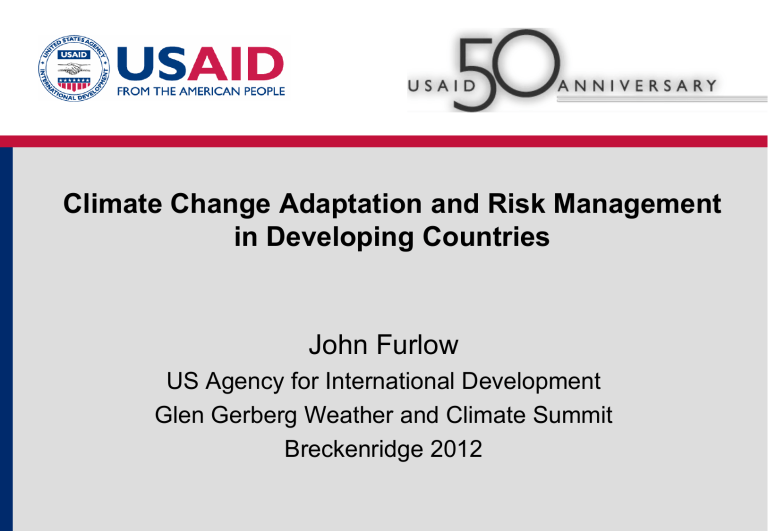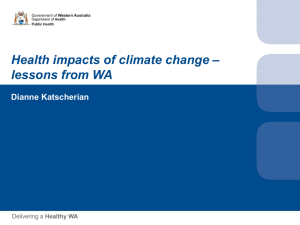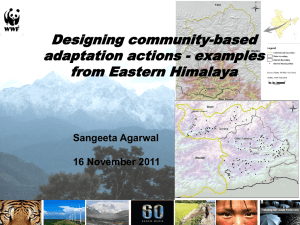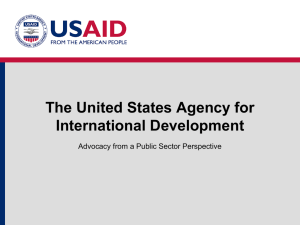Climate Change Adaptation and Risk Management in Developing

Climate Change Adaptation and Risk Management in Developing Countries
John Furlow
US Agency for International Development
Glen Gerberg Weather and Climate Summit
Breckenridge 2012
What Is USAID?
USAID at a glance
• An independent federal agency under the general policy guidance of the US Secretary of State
• Operating in 100 countries with over 75 field offices
• $ billions invested annually in:
• Water and sanitation
• Agriculture
• Democracy & governance
• Economic growth & trade
• Environment
• Education & training
• Health
• Humanitarian assistance
USAID’s Climate Change Program
Overall Goal: Assist countries as they develop in ways that reduce emissions while building resilience to climate change impacts
Mitigation:
Clean Energy: 23 countries, 11 Regions/Bureaus
Reducing net GHG emissions by spurring the deployment of clean energy technologies. Priority areas: energy efficiency, low-carbon energy, clean transport, and energy sector reforms.
Sustainable Landscapes: 14 Countries, 5 Regions/Bureaus
Reducing net greenhouse gas emissions from the land use sector (e.g., tropical forest destruction and degradation) and augmenting sequestration of carbon in landscapes, including building capacity to measure, report, and verify emissions reductions.
Adaptation: 19 Countries, 12 Regions/Bureaus
Building capacity in vulnerable countries and communities to prepare for, reduce, or cope with negative impacts of climate change; Designing resilience into development assistance.
Adaptation portfolio 2011
Africa:
Ethiopia
Kenya
Malawi
Mali
Mozambique
Rwanda
Senegal
Tanzania
Uganda
East Africa Regional
Southern Africa Regional
West Africa Regional
Asia:
Cambodia
Indonesia
Philippines
Timor-Leste
Vietnam
Bangladesh
India
Maldives
Nepal
Regional Mission-Asia (RDM/A)
Latin America & Carib:
Dominican Republic
Guatemala
Jamaica
Peru
Barbados and Eastern
Caribbean
South America Regional
23 countries
$139 million in total
Adapting to Climate Change
Impacts in Developing Countries
Challenges to Adaptation in Developing Countries
• Underlying development challenges
– Education
– Governance
– Health
– Infrastructure
• Poor historical records
• Poor current weather data
• GCM uncertainty
• Poorly adapted to current conditions
• Numerous pressing needs
What Is Adaptation?
• IPCC: adaptation is “Adjustment in systems in response to actual or expected climatic stimuli or their effects. . .”
– Process of examining and understanding vulnerabilities
– Responding in some way to reduce vulnerability, build resilience
Why Adapt to Climate Change?
Ethiopia: Rainfall, Ag GDP, GDP
• Developing country economies concentrated in climate sensitive sectors
• ~70% of developing country populations derive income from agriculture
Weather, Climate, and Livelihoods
Alerts for East Africa
Major crisis continues; response inadequate 06/07/2011
Conditions worsen in Eastern Horn 05/06/2011
Forecasts poor, crisis likely to worsen 03/15/2011
Poor Oct-Dec rainfall likely in East Africa 11/02/2010
Food security expected to deteriorate further 12/30/2009
Poor start of kiremt season in Ethiopia 08/13/2009
Forecast poor rains to deepen food insecurity 10/23/2008
High and rising food prices continue
Food aid pipeline faces serious shortfalls
08/12/2008
06/23/2008
Forecasts suggest increased food insecurity 03/31/2008
Making the Most of Adaptation Investment
Climate Stress in the Development Context
Economic drivers / Social development objectives:
Tourism, Agriculture, Manufacturing
Inputs or essential conditions:
Natural environment, fresh water, energy, transport systems, labor, safety, governance, policy, financing, public awareness
Stressors (climate, non-climate):
Changes in rainfall, temperature, SLR, corruption, pollution
Interventions:
Information, capacity building, public awareness, freshwater management, coastal/marine management
Understanding climate vulnerability
Vulnerability: determined by exposure, sensitivity, adaptive capacity
• Exposure: Is an asset out in the elements?
– Flooding, drought, erosion, sedimentation
– Agriculture is exposed, highly dependent on weather/climate
• Sensitivity: Does exposure matter?
– Are crops suitable to a range of temperatures and precipitation profiles?
• Adaptive Capacity: Can you respond?
–Ag sensitivity can be reduced with irrigation, drainage, crop selection
–Crop and economic diversification can reduce damages
–Insurance spreads risk
15
Objective: Health, productivity, food
Inputs : Infrastructure, water, ecosystems, management, information, climate, policy
Stresses
Non Climate
• Poor infrastructure, maintenance
• Lack of regulation
• Pollution
Climate
• Increasing temps
• Rainfall variability
Exposure
What
• Infrastruct.
• Populations
• Ecosystms
Where
• Coastal zone
• Estuaries
Vulnerability factors
Sensitivity
• Quality of infrastruct.
• Type of water source
• Housing
• Health status
Adaptive capacity
• EWS
• Governance
• Multiple sources
• Skilled decisionmakers
• Redundant systems
Potential impacts
• Damaged infrastructure
• Lost productivity
• Illness
• Food insecurity
Response options
• Seasonal weather forecasts
• Guidance and awareness
• Restore watersheds
• Redundant infrastructure
• Zoning, flexible land use
• Increase water storage
Climate Service Partnership
Climate Service Partnership
Growing consensus that providing climate information can help decision making
International Conference on Climate Services:
• NOAA, UK Met, German Climate Service,
WMO, Global Framework for Climate
Services, World Bank, USAID
Principles:
• Tailored to decision needs
• Focus on key development sectors
• Open access to data
USAID/West Africa: Climate Adaptation Support
Service for regional development
Value Chain of Climate Information
•Identify User Needs
•Translate Information for users
•Deliver Information
•Apply Information for decision making
•Robust Decisions
IRI – IFRC Map Room: http://iridl.ldeo.columbia.edu/maproom/.IFRC/.Forecasts/
SERVIR: Tools to Assist Development
21
SERVIR: Disaster Response
Vulnerability and Adaptation Training
Workshop
22
Climate Mapper Tool
Climate Mapper Continued
Rural Radio: RANET
Applying Weather and Climate information: Index Insurance
Four main “buckets” for risk management
Frequent, less severe events
Risk reduction
Risk retention
Risk transfer
Post-disaster assistance
Rare, very severe events
27
Risk reduction
Irrigation
Water use efficiency
Drought resistant varieties
Training on climate change
Access to forecasts
Reforestation
Community monitoring systems
Grain storage, seed banks
Retained Insurance Aid/Relief
Losses
Managing Climate Risks: Glacier
Lake Outburst Floods
Glacier Lake Hazards in Nepal
• Tourism: 50% of Nepal’s GDP
• Region accounts for 5% of arrivals
Some Statistics on our expedition:
• 35 scientists, development practitioners, journalists
• ~25 porters and guides
• ~12 vertical miles walked
• ~75 linear miles walked
• 18 days on trail
Thank You
jfurlow@usaid.gov
http://www.usaid.gov/our_work/environment/climate











